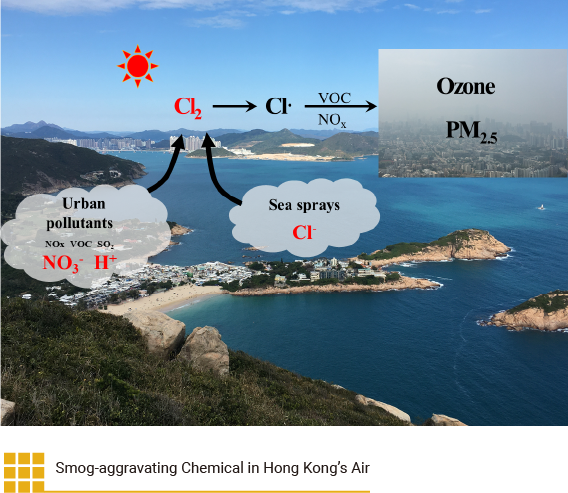CEE Researchers Discovered Smog-aggravating Chemical in Hong Kong’s Air

Prospective Students
Research
Graduates and Associates Corner

For other issues, please visit here.
CEE Researchers Discovered Smog-aggravating Chemical in Hong Kong’s Air
In a field study at coastal site in Hong Kong, a team of CEE researchers discovered unprecedented concentrations of molecular chlorine (Cl2) during autumn when ozone pollution reaches its annual peak. In collaboration of international scientists, the study team found that the high Cl2 is produced by interaction of man-made pollutants (NOx and acidic chemicals) with natural sea-spay particles. This pollution pathway is important not only for Hong Kong but also other coastal cities. The findings can help to adjust or refine measures to reduce ozone pollution.
The study results were published on 17 Feb 2022 in Nature Communications. The first author is Dr Xiang Peng who was a PhD student at the time of this study, and the corresponding author is Prof. Tao Wang of CEE. Other contributing authors included Prof. Hai Guo, Prof. Shun-cheng Lee, and additional PhD students and researchers from CEE, personnel from Hong Kong Environmental Protection Department, and scientists from the US, France, Spain, Sweden, Germany and mainland China. The study received funding support from the Hong Kong Research Grants Council, the Agence Nationale de la Recherche, the Swedish Research Council, and the European Research Council.
https://www.polyu.edu.hk/cee/news-and-events/news/2022/20220222_cee_researchers_discovered/

We use Cookies to give you a better experience on our website. By continuing to browse the site without changing your privacy settings, you are consenting to our use of Cookies. For more information, please see our Privacy Policy Statement.
Your browser is not the latest version. If you continue to browse our website, Some pages may not function properly.
You are recommended to upgrade to a newer version or switch to a different browser. A list of the web browsers that we support can be found here




